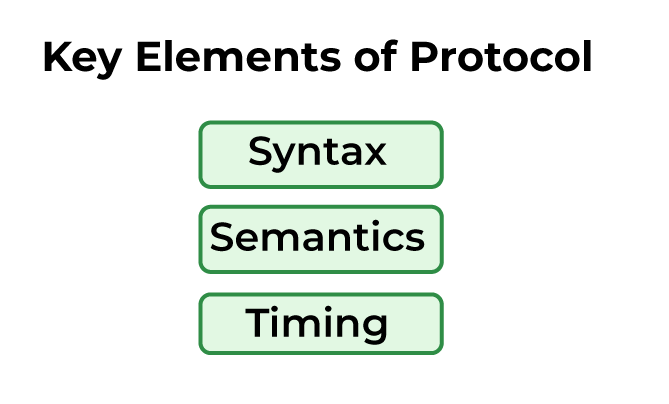Elements of Network protocol
Last Updated :
13 Apr, 2023
Pre-Requisite: Layers of OSI Model
Network Protocols are a set of guidelines governing the exchange of information in a simple, dependable, and secure way. Network protocols are formal standards and policies comprised of rules, methodology, and configurations that define communication between two or more devices over a network. To effectively send and receive information, devices on the two sides of a communication exchange must follow protocols.
Protocols
Protocols are the set of rules that govern data communication. Protocols can be defined as a communication standard followed by both the parties (Sender and Receiver) in a computer network to communicate with each other.
Key Elements of Protocol

Key Elements of Protocol
1. Syntax: Syntax basically represents the format of the data means in which order data is presented. It also indicates how to read the data. It simply means the way to represent data. For Example, let us suppose a data packet has 16 bits, in which the first 4 bits are the sender’s address, the last 4 bits are the receiver’s address and the rest is the message. So, this is a syntax to represent data bits.
2. Semantics: Semantics basically refers to the meaning of each section mentioned in syntax. It includes control information for coordination and error handling. It also specifies which file defines which action.
3. Timing: Timing simply means when the data is to be sent and how fast the data can be sent. For Example, if the Sender sends the data at 100 MBPS and the receiver receives it at 1 MBPS, then the data gets overflowed at the receiver end.
Functions of Protocol
The main functions of Protocols are discussed below:
- Establishment of Connection: There are two ways of data transfer, Connectionless or Connection-Oriented. Basically, services acquired by protocols are Connection-Oriented Services. It also helps during the transfer of large volumes of data.
- Encapsulation: A protocol describes how the data is encapsulated in packets. It is basically the process of distribution of one protocol to other.
- Data Transfer Management: It is simply the management of the flow of data to provide sequencing and matching.
- Segmentation and Reassembly: Segmentation is the process of breaking data into smaller blocks and adding some extra information for peer use and Reassembly means when the upper-level protocol combines to get actual data when we remove control information sent by the sender.
- Error Control: Error Control is simply the loss of data or sometimes damage in data upon transmission in data. It is implemented in two ways
- Error Detection
- Retransmission of Data
- Flow Control: The process of controlling the flow of data to limit the rate of data sent by transmitting frame. Techniques used for this method are Stop and Wait, etc. It is used to basically control the problems like data loss, data overloading, etc.
- Multiplexing/Demultiplexing: Multiplexing is a technique generally used in the context of Addressing. It is basically of two types:
- Upward Multiplexing
- Downward Multiplexing
- Addressing: Addressing is used during communication by defining addresses. The concept of Addressing is complex and includes addressing levels and addressing scope.
Protocols of Network Communication
Network communication protocol requires the following elements:
- Message Encoding
- Message Formatting and Encapsulation
- Message Size
- Message Timing
- Message Delivery Options
1. Message Encoding: A source message from the sender is encoded into signals or waves then transmitted through a medium wired/wireless then received and decoded and the message is passed to the destination. Encoding is the process of transforming a set of Unicode characters into a sequence of bytes.

Message Encoding
2. Message Formatting and Encapsulation: There is an agreed format between the sender and receiver. It encapsulates information to identify the sender and receiver rightly. A message format will depend on the type of message and the medium through which the message is delivered. Message encapsulation is a process that is used to place one message inside another message for transfer from the source to the destination.
3. Message Size: Here long messages must break into small pieces to travel across a network or The process of breaking up a long message into individual pieces before being sent over the network. For example, In mobile phones, SMS limits message size to 160 normal alphabet characters. For non-alphabet characters, It needs 16 bits of data to represent them limiting the size to 70 characters only.
4. Message Timing: It manages flow control. Acknowledgments response time out. This requires certain timing control information. It checks for any delays in data passing. It includes rules like Access method, flow control, and response timeout.
5. Message Delivery Options: There are different delivery options like Unicast, Multicast, and Broadcast. Sending information to a single person is referred to as a one-to-one delivery and is called unicast which implies that there is only one destination (single destination). To communicate information to more than one person (a group of people at the same time) is referred to as one-to-many and is called multicast which implies that one sender to multiple destinations/recipients for the same message. Sometimes information is to be communicated to every person in the same area. This is referred to as one-to-all and is called broadcast which implies that one sender sends a message to all connected recipients.
Like Article
Suggest improvement
Share your thoughts in the comments
Please Login to comment...